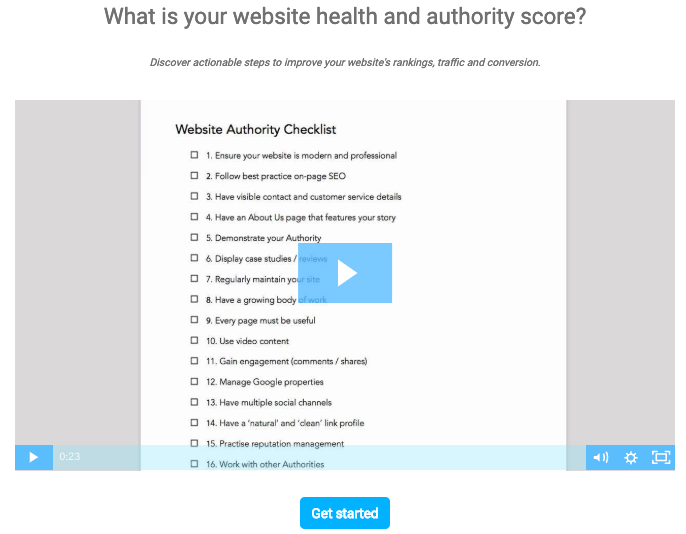Before reading this article the quickest way to evaluate your website’s health is to take our DIY Website Health Quiz- click here. It will give you actionable tips and tricks to improve your traffic and conversion – click here.
How Google determines what a good site is?
Google has very particular things it looks for in a website and it will reward those demonstrating these qualities with high rankings. The primary two key elements are the site usability and its technical setup. For usability, the way that Google determined what was important was by doing some analysis. They took a group of quality checkers and they gave them a list of good sites and a list of bad sites. They asked them to rate the sites.
They asked them questions like:
- Would you trust this website with your credit card?
- Would you trust your son or daughter to browse this website unsupervised?
- Would you want to come back to this website?
They asked them all of these questions and gave them a long list of websites, across a large cross section of people. Then they could determine what good sites were or what characteristics were on a good site and what characteristics were on a bad site. With those characteristics they started to look for the correlation. What things needed to be on these sites? What are the qualities of a good website?

Be good and Google will love you.
What makes a good quality site?
It’s not that you need to have every single one of these, but if you don’t have enough of these items, then Google will say, we don’t consider you a quality site.
Ensure you have the follow on your site:
- About Us page. Good sites have an About Us page that talks about you and what it is that you’re doing and tells your story.
- Contact Us page. Google has realized that good quality sites have their address published or they have a form which people can submit to contact the webmaster. They might have a phone number; that type of information is a good quality signal for Google.
- Privacy policy or a disclaimer or terms of service page. Those things generally tend to exist on a good quality site.
- Site map, a way that people can see what is actually on your site.
- Copyright with the current year so it doesn’t look like it’s a hundred years old. Obviously they want good, unique, high quality content.
#1. Have good content
They also want to make sure there is some good text on the page. Google can only read words, it can’t read images. So Google needs to sink its teeth into some words. If you’ve got a high proportion of pages that are just images, you’ll tend to not do as well in the search engines. Google needs something to sink its teeth into.
If you want to do an Instagram post or something like that or post a photo, that doesn’t mean you have to put words on it. Occasionally you can sneak it through but these are the guidelines that Google gives. Sometimes you can break the rules, but more often than not, if you can follow the rules, you’ll be well set up.
#2. Link to quality sites
Google also wants to see you linking out to some good quality sites. Obviously off to your social media, but to other sites in the industry as well. These are all just good quality factors that Google will see, from a usability perspective, you’re providing a good user experience. You haven’t gone too ad heavy, you haven’t put too many ads above the fold, when someone first lands on the page. You want to make sure the user can get straight into some good quality content.
#3. Review your technical setup
The second aspect is the technical. Google really doesn’t like duplicate content. So you want to avoid using the same post on your site loads of different times. It’s ok to have the occasional piece of duplicate content if it’s posted on another website.
If you have a press release done or you’ve got a guest post and someone else posted something over on their website, it’s ok occasionally if there is some duplicate content but you don’t want to have too much. Google hates, particularly, a lot of onsite duplicate content, whether that means duplicate title tags or duplicate descriptions. Each blog post you create, you really want to have a unique title and a unique description.
#4. Set up Google Search Console
You can set up a thing called Google Search Console. It’s free. It’s like Google Analytics only focussed more for your webmaster, depending on who is managing your website. It will give you insight into what Google has identified. It’s actually the way Google communicates with you. You want to make sure that you have Webmaster Tools set up so if Google wants to talk to you they can because they’ll do it through Webmaster Tools.
It will give you insights into if their having trouble crawling your website. If Google’s spider is having trouble crawling your website, they’re going to let you know inside your Webmaster Tools.
Technicals include site speed and making sure that you have a low bounce rate. Low bounce rate just comes from having good quality content, and site speed is like web design 101. If you’ve got a good web designer or you’re using WordPress and you’ve got a modern theme, a lot of these things are going to be built in. But if you’ve got a website that was built in 1995, it’s probably time to update your template and get something that is a little bit more in line with Google’s technical specs.
#5. Improve Your On-page SEO
On-page SEO is another important aspect of technicals and among the most crucial qualities of a good website. This might be what you previously thought SEO was all about. It’s still important that we choose the right keyword and we put the right keyword in the relevant places. This is part of the technicals because inside Google Webmaster Tools they talk about, we really don’t like duplicate title tags and descriptions and things like that. They’ll notify you inside Webmaster Tools if they feel like you’re not following their rules.
We want to make sure we get our on-page SEO set up correctly. When it comes down to keywords, Google really revolutionized the industry. Keywords now have become very much a core driver of the way the web works.
How Google revolutionised the industry
Previously, websites used to look like a directory where you’d have categories and you’d pick your category and you’d drill down a little bit deeper. You’d keep on going down until you found the website that you were looking for.
If you were looking for something under health, you’d click on the health tab. You might say, this is about fitness, so you’d click on fitness. Then you might say, right, I want to find personal fitness blogs. Ok, I’ll click on the blog section. You’d keep on drilling down until you found what you were looking for.
Google pretty much turned this on its head and this is how they changed the industry. They said, we don’t know what you’re looking for, so we’re just going to give you a blank page and you type in what you want. Then we’ll serve the best and most relevant results to you. That’s pretty much how they turned search on its head. They said, we’re not going to show you anything until you tell us what you want.
The way you tell Google what you want or the user wants, is by typing the keyword into Google. That’s why keywords became so important on the web. It’s the way that Google knows what the person is looking for and will help them determine what result they serve up that is going to be relevant for them. So doing good keyword research is another important aspect of your technicals.
Putting it all together…
To make your site acceptable to Google and get high rankings, it is important to ensure that the usability and technicals are as good as they can be. Google has made it clear what they consider the qualities are of an excellent website, so it pays to put in the time and effort to make sure these are found on your site.
If you’d prefer to leave this to the experts – click here to have one of our team review your website.




I totally agree with you. Love your website user ( by providing valuable content that they like) and google will love you back (TWICE!)